
When planning a basement, standard dimensions typically refer to the height and footprint. Most building codes require a minimum ceiling height of about 7 to 8 feet (2.13 to 2.44 meters) for finished basements to provide comfortable living space. The floor area usually matches the main floor of the house, with widths and lengths often ranging from 20x30 feet to 30x50 feet (6x9 meters to 9x15 meters), depending on the home's size and layout. It's important to consult local building codes and consider your intended use (living space, storage, or recreation) when determining the best dimensions for your basement project.
Ceiling Height
The standard ceiling height for a basement typically ranges from 7 to 8 feet, with 7 feet being the minimum required by most building codes for livable spaces. A higher ceiling can enhance the perception of space and improve ventilation, making the environment feel more open and inviting. Specific requirements may vary by locality, so it's essential to consult your local building regulations when assessing your basement. Aim for a ceiling height of at least 8 feet to maximize both comfort and functionality in your basement design.
Column Spacing
In basement construction, column spacing typically ranges from 10 to 20 feet, ensuring structural integrity while maximizing usable space. Proper column spacing reduces the need for additional support beams, which can further enhance accessibility and aesthetic appeal. For optimal load distribution, engineers often calculate column placement based on the total live load of 40 pounds per square foot. By strategically designing column spacing, you can create a more open and functional area that meets both safety standards and your design preferences.
Floor Thickness
The standard floor thickness for a basement typically ranges from 4 to 6 inches, depending on the load-bearing requirements and the type of flooring used. A thickness of 4 inches is generally sufficient for standard residential applications, while 5 to 6 inches may be necessary for areas expecting heavier loads or when using reinforced concrete. Insulation can also play a critical role, as adding materials beneath the floor can improve energy efficiency and moisture control. Ensuring proper installation and adequate thickness helps prevent issues such as cracking and settling over time.
Wall Height
In residential construction, the standard wall height for basements typically ranges from 8 to 9 feet, providing adequate headroom and enhancing usability. A height of 8 feet is often the minimum, allowing for proper insulation and ventilation, while a height of 9 feet offers more spacious feel and flexibility for future modifications. You may also consider local building codes, as some regions have specific requirements influencing basement wall height. Remember, increasing the height can improve natural light exposure if you install larger windows, making your basement more livable and attractive.
Staircase Width
The minimum standard for basement staircase width is typically 36 inches to ensure safe and comfortable passage. A wider staircase allows for easier movement, especially when carrying items such as furniture or appliances, enhancing accessibility. Building codes in many regions may require wider stairs if the basement serves as an exit point during emergencies, which could mean a width of 42 inches or more. Prioritizing your staircase design not only improves functionality but also adds to the overall safety of your basement renovation.
Doorway Dimensions
The standard doorway dimensions for basements typically measure 32 to 36 inches in width and 80 inches in height, accommodating most residential door types. A minimum width of 32 inches ensures accessibility for furniture and larger items, while 36 inches is often recommended for wheelchair access. It's crucial to maintain a headroom clearance of at least 6 feet 8 inches (80 inches) to comply with building codes and provide comfort when entering or leaving the space. Ensuring these dimensions not only enhances usability but also contributes to safety and efficient space utilization in basements.
Window Size
Basement window sizes typically range from 24 to 36 inches in height and 36 to 48 inches in width, ensuring proper ventilation and egress. Your local building codes may require a minimum window opening of 5.7 square feet for safety reasons, especially if the basement is used as a living space. An appropriately sized window not only maximizes natural light but also helps in regulating indoor temperatures, increasing comfort and energy efficiency. When selecting window sizes, consider the overall design and functionality to enhance both aesthetics and safety in your basement.
Ventilation Requirements
Proper ventilation in a basement is crucial for maintaining air quality and preventing moisture buildup. The recommended airflow rate is 0.35 air changes per hour, ensuring adequate exchange of indoor and outdoor air. Ventilation systems should ideally incorporate exhaust fans, passive vents, and dehumidifiers to combat humidity levels exceeding 60%. Implementing these strategies not only safeguards against mold growth but also enhances the comfort and longevity of your basement space.
Insulation Depth
Insulation depth in basements typically ranges from 2 to 6 inches, depending on local climate conditions and building codes. Proper insulation reduces heat loss, helping maintain a consistent indoor temperature and potentially lowering heating costs by up to 20%. Using materials such as foam board or spray foam can significantly enhance moisture resistance, crucial for preventing mold growth in below-grade areas. Assessing your basement's insulation depth can ensure compliance with energy efficiency standards, contributing to a healthier living environment.
Egress Window Specifications
Egress window specifications are crucial for ensuring safety and compliance in basement design. The International Building Code mandates that egress windows must have a minimum opening of 5.7 square feet, with a minimum height of 24 inches and width of 20 inches. The bottom of the window must be no more than 44 inches above the floor, allowing for safe exit in emergencies. Installing a properly sized egress window not only enhances safety but also improves natural light and ventilation in your basement space.
